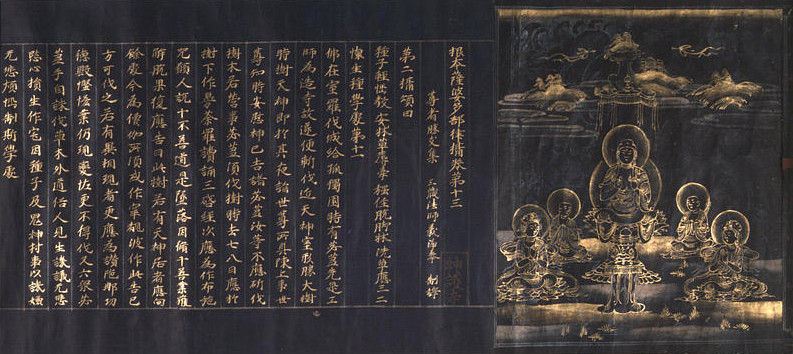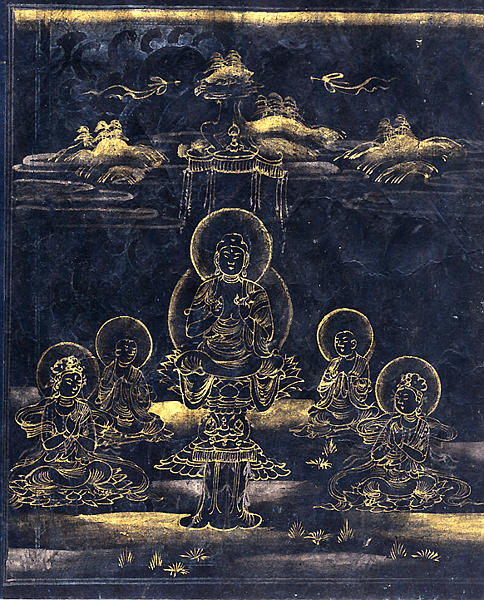紺紙金字根本薩婆多部律摂巻第十三(神護寺経)
- 平安時代後期
- 12c
- 紺紙金字金銀泥
- H-25.8 W-610.3
- 所蔵
- 神護寺伝来
平安時代後期 12世紀
紺紙金字
縦:25.8cm 全長(見返し共):610.3cm
紺紙の経典は,平安時代後期に盛んに書写されたが,その紺紙は瑠璃地の仏国土をイメージしたものと考えられている。そして,経文を金字で書写することは,仏の教えを荘厳していることになるが,光り輝く仏身そのものを表現したものともみられる。銀泥で引く界線も光り輝く仏の教えを荘厳していることになる。
このような紺紙金字の経典には,ほとんどの場合,表紙には金銀泥で宝相華唐草文が描かれ,見返しにも金銀泥で経典の内容を絵画化した経意絵や霊鷲山を背景とした釈迦説法図が描かれていることが多い。加えて,そのほとんどには金銅製魚子地撥型の軸首が装着されている。
この一巻は,巻首首題下に「神護寺」の朱方印が捺されていることから,神護寺に伝来し,一般に「神護寺経」と呼ばれている紺紙金字一切経のうちの一巻であることがわかる。『神護寺略記』には三部の一切経が記載されているが,そのうちの「金泥一切経 貞元録」に相当するとみられ,その記述によれば,鳥羽天皇の発願になったものを後白河法皇が施入したと伝えられている。
この「神護寺経」も,通例のように表紙には金銀泥で宝相華唐草文が描かれ,見返しには金銀泥で霊鷲山を背景とした釈迦説法図が描かれている。ただ,図様は簡略化され,パターン化しており,ほぼ同一の表現となっている。軸端もやはり当初の金銅製魚子地撥型の軸首が装着されている。
制作年代に関しては,一切経とともに伝来している経帙二百二枚のなかに久安5年(1149)の墨書銘のものがあることから,この頃の制作と考えられる。
「貞元録」によったとすれば,もと五千四百巻近くの経巻があったと考えられるが,現在,もとの神護寺には二千三百十七巻が伝存しており,重要文化財に指定されている。このほか,巷間に流出したものも多くあるが,平安時代後期を代表する紺紙金字一切経の遺品として実に重要な古写経である。(赤尾)
薩婆多
薩婆多部
仏教の部派の一つで、説一切有部と同じ。日本の奈良を中心とする南都仏教では「さつばた」、比叡山延暦寺を中心とする天台宗では「さはた」と呼んだ。(説一切有部を参照)
神護寺
神護寺(じんごじ)
京都市右京区梅が畑高雄町。真言宗東寺派別格本山。
延暦年間(782-805)に和気清麻呂が河内に創設したが、天長1年(824)に現在神護寺のある地にあった高雄寺とあわせたといわれている。空海も一時ここに居たことがあり、後には後白河法皇や源頼朝等の庇護を得た。
大師堂は仁安3年(1168)の建物。
神護寺経帙
Catalogue Entry
Scroll 13 (Jingoji Sutra)
Late Heian period, 12th century
Handscroll, gold paint on dark blue paper
Height, 25.8cm;
overall length (including frontispiece painting), 610.3cm
A number of sutras were copied onto dark blue paper during the late Heian period, and the blue is thought to have been meant to represent an image of the lapis lazuli Buddha world. The use of gold paint to write the texts of the sutras was an act of reverence toward the Buddha's teachings and can also be seen as a representation of the shining bright body of the Buddha himself. The boundary lines drawn in silver paint were yet another method of revering the shining teachings of the Buddha.
Sutras created in gold paint on dark blue paper were, in most cases, accompanied by a cover sheet decorated with hosoge karakusa vining patterns, and the frontispiece section would include a painting in gold and silver paint representing a scene or passage from the sutra text. There are also many examples which show an image of Shaka (S⇔akyamuni) preaching against a backdrop of Vulture Peak. In addition, the majority of these sutras are adorned with plectrum-shaped scroll roller ends made of gilt bronze in a fish-roe ground pattern.
This single scroll has a red letter square seal that reads "Jingoji" impressed beneath the title at the front of the scroll, and thus it has been identified as 1 scroll from the "Gold Letter on Blue Paper Buddhist Canon" that was handed down at Jingoji and has hence come to be known as the Jingoji Sutras. 3 sets of the Issaikyo, or Buddhist canon, are recorded in the Jingoji Ryakuki, and this scroll is thought to accord to the one described as being painted in gold and recorded during the Jogen period (976-78). That notation goes on to state that Emperor Toba ordered the copy and that it was presented by the Retired Emperor Goshirakawa.
As in normal examples of this kind of sutra, this scroll of the Jingoji Sutras has a cover sheet decorated with hosoge karakusa vining patterns painted in gold and silver paint, and the frontispiece painting is an image of Shaka preaching against a background of Vulture Peak painted in gold and silver paint. However, the iconography of this scene has been abbreviated and is somewhat patterned so that all of the elements are given a generally uniform expression. The roller bar ends are the original gilt bronze plectrum-shaped rollers decorated with a fish-roe ground.
Regarding the date of this work, the Jingoji Issai-kyo has come down through the centuries with a chitsu-bound book of 202 pages with a date inscription of 1149 (Kyuan 5) written in black ink, and it is thought that this scroll was created around that period.
In accord with the "Jogen record," it is thought that there were originally close to 5,400 sutra scrolls, and at present, the original owner of the scrolls, Jingoji, still preserves some 2,317 scrolls which have been designated Important Cultural Properties. In addition, there are many scrolls from this set which have found their way into the world, and they are considered extremely important antique sutra scrolls representative of the beauty of the gold-on-blue Buddhist canon created during the late Heian period. EA



